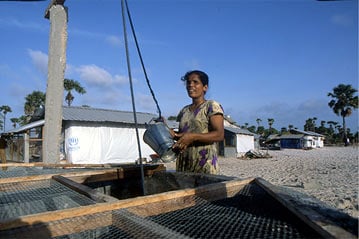UNHCR focuses post-tsunami efforts on Aceh's west coast
UNHCR focuses post-tsunami efforts on Aceh's west coast

BANDA ACEH, December 14, (UNHCR) - After a massive three-month emergency relief operation in Indonesia's Aceh province in the immediate aftermath of the 26 December 2004 tsunami, the UN refugee agency returned to the province in June 2005 to help out with the reconstruction effort by rebuilding communities along Aceh's badly damaged west coast.
During the emergency phase of the operation from January to March 2005, UNHCR ferried in relief items such as tents, blankets, kitchen sets and plastic sheeting by helicopter to around 100,000 tsunami survivors along the west coast. It was clear then that any rebuilding efforts would have to take a holistic approach, taking into account the social and physical needs of shattered communities, many of which had lost a substantial proportion of their members to the deadly tsunami.
Indonesia's combined death toll for the tsunami and the 28 March earthquake in Nias Island was 131,934 with half a million people made homeless, according to June figures of the government Reconstruction Agency for Aceh and Nias, BRR.
In this second rebuilding phase, UNHCR is focusing its efforts along a 200km stretch of Aceh's west coast where the priority is integrated, holistic community rebuilding involving community members in the reconstruction. Schools, health clinics, places of worship, administrative offices, family housing are part of the building programme. The refugee agency is working closely with the Indonesian BRR, and the public works department.
The village of Krueng Sabee, where over half the population was swept away by the tsunami and 4,000 were displaced, is a pilot project for the rebuilding programme. Many of the villagers had got to know UNHCR in the desperate days after the tsunami when the refugee agency was delivering the initial emergency aid supplies.
"We were so happy to have our prayers answered when we heard that UNHCR was going to return to Krueng Sabee. Our people have waited for this moment for so long," said Pak Yusof, head of Krueng Sabee's local coordination unit.
With help from RedR - an Australian organization of disaster relief engineers - UNHCR is building more than 1,000 permanent homes in Krueng Sabee made out of concrete blocks and designed to stand an earthquake of 6.5 magnitude and a 1.5 metre tsunami wave. The homes are also designed with the Acehnese lifestyle in mind, and can be easily partitioned or extended by their owners. For the displaced, having a home again is extremely important physically and psychologically.
"It will be great to have a home as I will feel that no storms can touch me then," said 31 year-old widow Ibu Jalinar, who is currently living in a UNHCR tent in Krueng Sabee. "It will be more comfortable, and so I think it will be easier to look for a job when I am living in a house," she added.
The villagers are themselves involved in the rebuilding - helping out with labour, and in some cases providing a particular expertise. In the process, they are able to earn some money, and learn new skills.
Already, work has begun on 129 sites in Krueng Sabee, which comprises six villages. The sites are being pegged out and foundation slabs laid. And, the pace of work is set to increase. By 26 December, the first anniversary of the tsunami, all of the 1,022 houses needed in Krueng Sabee will have been contracted out for rebuilding, or will actually be under construction. The first 200 families to get new homes were selected, based on their special needs, through a process of community consultations.
One of the first requests from Krueng Sabee residents to UNHCR and RedR was to build four community halls in time for the holy month of Ramadan. These were quickly completed, and repair work on the only junior high school in the sub-district is almost complete. The heart of the community is starting to beat again. Where the needs exceed UNHCR's expertise or capacity, other UN or non-governmental agencies have been being approached - for example to assist in road construction, drainage and livelihood programmes.
Eight kilometres away in Calang, the district capital of Aceh Jaya, UNHCR has started building another 272 houses for tsunami survivors as part of an inter-agency effort to rebuild homes in that area. And, in the provincial capital of Banda Aceh, UNHCR is helping the local government plan and design rental apartments for those people displaced by the tsunami who did not own their own property or homes. In this case, other agencies will actually build the homes.
Some normality is returning to Aceh, with markets now busy again, shops and stalls reopening. The agreement signed in August between the government and the rebels of the Free Aceh Movement (GAM) to end almost 30 years of conflict has also improved confidence about the future.
However, a year after the tragedy a great deal still remains to be done to reconstruct infrastructure, homes and livelihoods.
In the Indian Ocean Flash Appeal of January 2005, UNHCR asked for US$ 60 million for its tsunami operation in Indonesia. It has received about two-thirds of that amount - some US$ 39 million made available for the tsunami relief operation in earmarked and broadly earmarked contributions. The latest figures, (up to 31 October 2005), show that by then US$ 11.23 million had been spent, including on relief operations on the island of Nias, which was badly hit by a major 8.7 magnitude earthquake on 28 March 2005.
By Geraldine Ang in Banda Aceh, Indonesia








